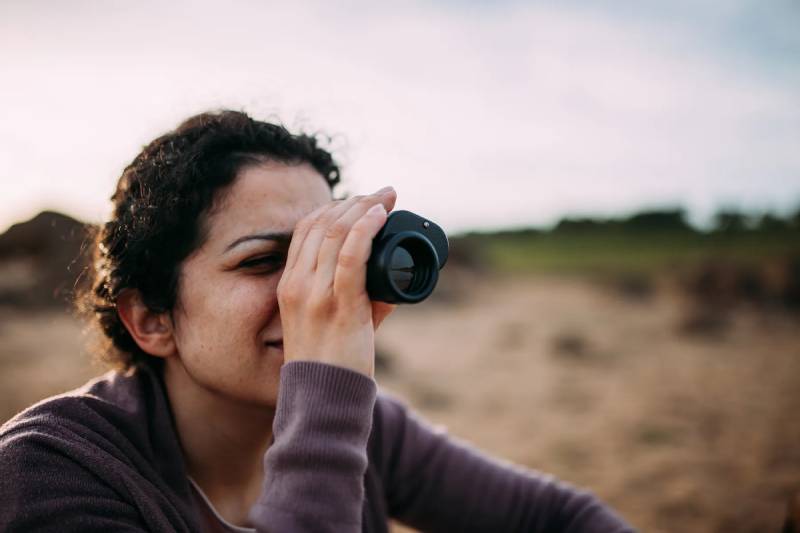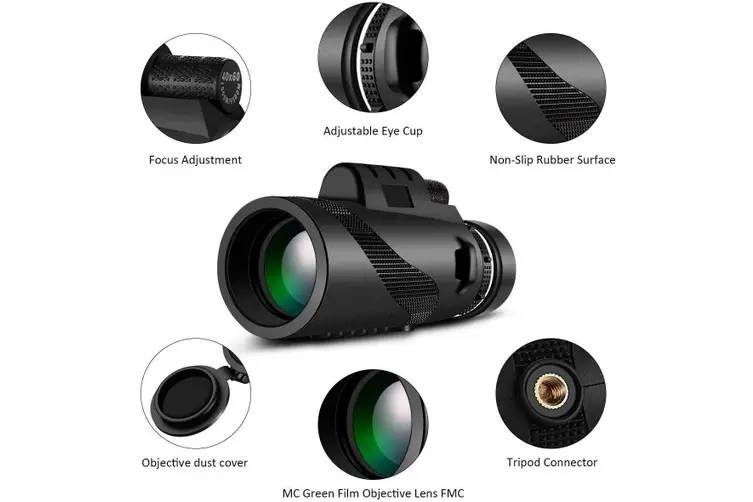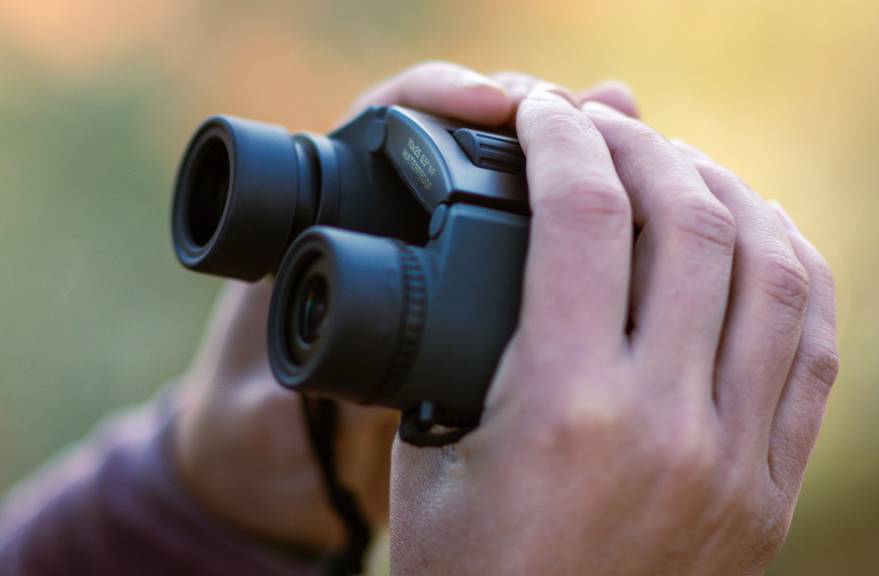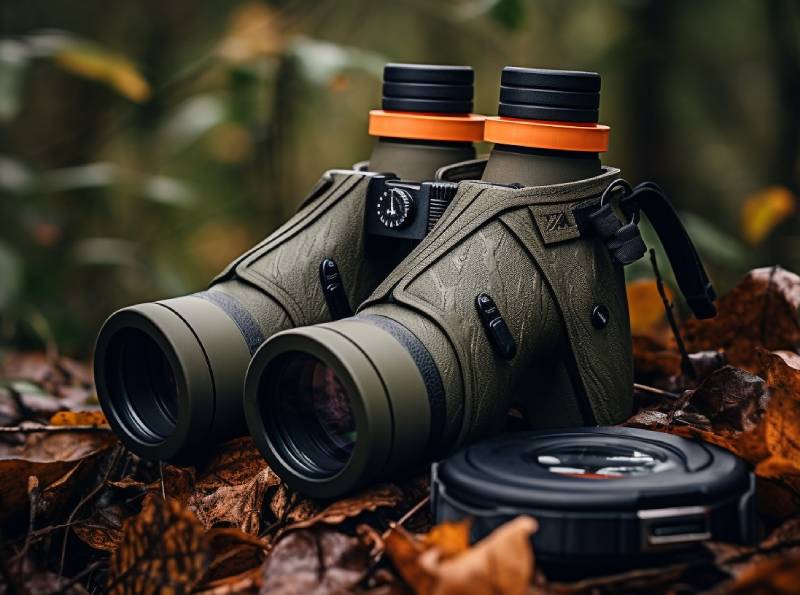When we think of a single lens, the monocular and the telescope immediately come to mind. But what’s the difference? Monocular and telescope are basically the same: they are both designed to magnify distant objects.
The difference between a monocular and a telescope lies in what you can observe. With a monocular, you can only observe things on earth, even if very distant, while with a telescope you can observe stars, planets, constellations. A telescope can be very large, heavy and not suitable for travel.
The monocular (from the Greek “monos” which means “one” and the “oculus” which means “eye”) is a professional optical instrument designed to observe distant objects through a single lens. It is nothing but a small telescope that is used with one eye held in the palm of the hand like binoculars.
Binoculars and monoculars share the same function: watching clearly landscapes and objects distant from us.
On the market, there are no pocket binoculars or monoculars that are powerful enough to look at the moon in detail, but there are various types suitable for everyday life.

ADVANTAGES AND DISADVANTAGES OF MONOCULAR
Among the advantages of the monocular, there are certainly pocket-size and lightweight: small, compact and light, it is suitable for every occasion. These features make the monocular a perfect tool when there is little space available and when, even a few grams of weight, can make a difference in the backpack or hand luggage.
From a functional point of view, it offers the same levels of magnification and resolution as normal binoculars. But as it has a single lens instead of two, the monocular costs less.
Another advantage is having a free hand. It could be something trivial, but think about the freedom when holding trekking poles, a golf club or an umbrella.
The monocular focus is designed for one eye and gives the possibility to observe really sharp images with defined outlines. There are people who have different diopters between one eye and another, using binoculars an optimal focus would be difficult to achieve. With the monocle, on the contrary, it is possible to adjust the focus according to the right or the left eye.
The disadvantage of the monocle is the lack of a relaxed vision. As the concentration is all focused on one eye, this can lead to rapid fatigue and a narrower field of view compared to the double lens of the binoculars. For this reason, the monocle is most suitable for quick observations.
HOW TO CHOOSE A MONOCULAR
The monocular is a never-outdated accessory and, in recent years, more and more travelers are getting used to bringing it during their trips. Animals, plants, mountains, coasts, urban centers, towers, bell towers, skyscrapers … All the beauties of the world close to our eyes!
The key feature of a good monocular are:
- MAGNIFICATION. The power of the magnification is expressed in two numbers, for example 12×50. Understanding what these numbers mean is quite easy. The first number indicates the magnification capacity, in this case, the subject appears 12 times closer than to a naked eye. The greater the magnification, the better the observation of distant objects. A higher magnification is not necessarily a good thing because, above 12x, the angle of view reduces and the vibrations produced by hand movements make the image unstable. For this reason, we recommend installing the monocle on a support or on a tripod. The higher the magnification, the lower the angle of view. The second number indicates the diameter of the objective, in our case 50mm. The larger the diameter, the greater the amount of light will be gathered. For observations in low light conditions, at dawn, at dusk or in the woods, you will need lenses with a larger diameter. But with a larger objective size, the weight increases as well, and price also goes up almost exponentially.
- LENS COATING. Monocular and binocular lenses have optical coatings to improve the amount of light they gather. The coating reduces the amount of light reflected and lost. Coatings prevent reflection, minimize light loss, enhance image contrast and sharpness. Multiple layers of anti-reflective coating have a better performance than a single layer. There are 4 types of lens coatings:
- C (Coated) – a single layer antireflection coating on some lens elements;
- MC (Multi Coated) – at least some surfaces have multiple layers of anti-reflection coatings;
- FC (Fully Coated) – one anti-reflective coating on both sides of the objective lens system;
- MFC (Multi Fully Coated) – multiple coatings on all lens surfaces and prisms with a result of better light transmission, bright, sharp and contrast images.
- PROFESSIONAL LENSES. On the market, there are lens made of plastic that are cheaper, lighter and more impact-resistant compared to the glass lenses. They are suitable for climbing and intense excursions where the integrity of the lens is essential but, in some cases, they do not guarantee clear vision and professional use. The most used glasses are BaK4 and BK7. Bak4 is a denser prism and transmit more light than BK7 as to ensure clear images and more defined colors.
- DIOPTER ADJUSTMENT. The monocular equipped with a diopter adjustment ring allows to correct the vision for sharper and clearer observation, even wearing glasses.
- RUBBER ARMOUR. Non-slip rubber body armour ensures a sure grip and protection from impact and humidity. Even the lens caps perform an important function to protect the glass and keep it safe and dry.
- WATER RESISTANT, ANTI-SHOCK, FOG-PROOF. A high-quality monocular is resistant to water (but it does not mean it can be dip under the water) and shock-resistant. The nitrogen filling between one lens and the other makes the monocular fog-proof, ensuring optimal performance even in the rugged conditions.
- BUILT-IN FUNCTIONS. Some monoculars include additional functions such as a compass for orientation, a torch to illuminate the surrounding area, a laser to indicate distant objects and many other usages.
- ADDITIONAL ACCESSORIES. Depending on the use, you may need to stabilize the monocular for a stable observation. The tripod performs this function and guarantees a static position for sharp images. In recent years, the pictures taken with a phone have grown exponentially and for this reason, some monoculars also include the smartphone support to capture distant details. Accessories such as protective pouch, lace for a secure grip and cleaning cloth allow you to have everything you need at your fingertips. Read our guide on how to attach the smartphone holder and take care of the lens.

Monocular with tripods and smartphone holder
WHY YOU SHOULD BRING A MONOCULAR ON A TRIP?
Do you know that a monocular could have many uses while traveling?
When we think of the monocular, the first application that comes to mind is the observation of nature and animals during excursions. In reality, you can use it everywhere:
- While traveling to have a closer view,
- On the boat to admire the shore from another perspective,
- During outdoor sports such as golf,
- During sports events and football matches,
- At concerts and events to have a clear view,
- At the theatre to admire plays closer,
- In the city to search for road signs and billboard at the distance,
- At the station to read the timetable clearly,
- In the museum to read captions and comments of artworks,
- During excursions to observe a distant landscape and facilitate the orientation.
HOW TO TAKE CARE OF MONOCULAR
A high-quality monocular can ensure great performance, but the care and cleaning of the lenses are essential for long-lasting and efficient use. Outdoor activities require a solid and robust structure of the monocular to resist accidental impacts. The lens needs to be protected with the covers to prevent dust and humidity from reaching inside.
To remove dust and keep the lenses intact for a long time, use a microfiber cloth and make circular movements. Even if scratched, the lenses cannot be replaced, so precaution can really make a difference. To limit the risk of internal condensation, the monocular must not be immersed in water (even if it is water-resistant) and always stored in a protective pouch.
You can read the ultimate guide where we explain in detail how to take care of the monocular lens.
Find out our 12×50 monocular telescope equipped with tripods and smartphone holder to discover the world around you and capture your emotions! Our package includes: 12×50 mm monocular telescope, tripods, smartphone holder, carrying case, cleaning cloth, wrist strap and instructions.
Observe farther with Royal Eagle Road!
Royal Eagle Road 12×50 mm monocular telescope with tripods and smartphone holder






